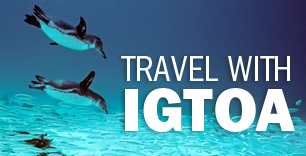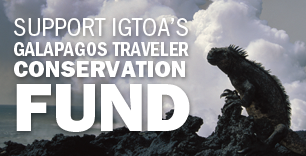Plants of the Galápagos
Vegetation Zones
Much like the people who came to live in the Galápagos, the plants that found a home in the islands had to be hardy types. These rugged, plant “pioneers” crossed oceans to get here — carried as seeds by birds (about 60 percent), by wind (about 31 percent), or by rafting in (about 9 percent). Then, these plants had to learn to survive in an often-hostile environment. Because relatively few managed the feat, there are far less plant species in the Galápagos Islands than there are in similar environments on the South American continent.
Most of the land area in the archipelago is semi-desert. Only the higher sections of the larger islands receive enough rain to be considered lush, verdant, and tropical. The south sides of the islands are wetter than the north due to a year-round, prevailing wind from the southeast.
Because the islands originally hosted very few insects or animals for pollinating flowers or dispersing fruits, the plant life here had little need to develop attractions for them. There are very few big, showy flowers or fleshy fruits. Looks, however, can be deceiving: The flora of the Galápagos is anything but straightforward and simple. Among the approximately six hundred vascular native plant species, subspecies, and varieties, about 35 percent are endemic. Combine this with about five hundred species of mosses, lichens, and liverworts and two hundred species of introduced plants — and the fact that, as a whole, the islands are still “young” in geological terms, so many plants are still evolving — and the flora of the Galápagos makes for a complex ecosystem.
In fact, some plant species here are so unique that they are grouped in their own endemic genera. These include Scalesia, the “daisy tree,” which has split into at least twenty separate species, including longhaired scalesia (Scalesia villosa), cut-leafed daisy (Scalesia incisa), and heart-leafed scalesia (Scalesia cordata). There are endemic genera of cacti, too: Brachycereus, the lava cactus; and Jasminocereus, the candelabra cactus.
The flora of the Galápagos gets even more complicated when you look at individual islands. Because of their separation, considerable variation in altitude, and difference in ages — Isabela and Fernandina are younger and believed to have less well-developed soils than older islands, such as Santa Cruz, Santiago, and San Cristóbal — there is endemism and species diversity even among them.
Because of these factors, Galápagos flora is best described by plant zones. Currently, there are seven, generally accepted vegetation zones in the islands:
The Moist Zones:
Today, the flora of the Galápagos is still facing challenges, much like the plant “pioneers” did. But strides are being made to combat those obstacles. Use the plant checklist below to see how many of these hardy types you can spot on your own adventure in the Galápagos!
Littoral (or Coastal) Zone
From the edge of the ocean to approximately fifty to one hundred miles inland, the narrow strip of the Littoral Zone is populated by plants that are able to tolerate salt. Since most of these plants arrived by ocean currents, many of them are not endemic.
Saltbush (Cryptocarpus pyriformis), a low, creeping evergreen shrub, is commonly found in this zone, along with two types of carpetweed; one with pink flowers (Sesuvium portulacastrum) and one with white flowers (Sesuvium edmonstonei). Beach morning glory (Ipomoea pes-caprae) stretches out long, creeping arms on the beaches and dunes.
Littoral Zone vegetation is also found around saltwater lagoons. This is where mangroves thrive. These evergreens tend to have heavy, waxy, or fleshy succulent leaves.
There are four species of mangroves in the Galápagos: black (Avicennia germinans), button (Conocarpus erectus), red (Rhizophora mangle), and white (Laguncularia racemosa). These plants are important players in the Galápagos; they help to protect the coastline from erosion caused by waves and storms. They provide nesting and resting places for hundreds of bird species, such as finches, herons, mockingbirds, and yellow warblers. Shallow waters within mangrove swamps provide nurseries for young fish, crabs, mollusks, rays, and shrimps; and fallen mangrove leaves and branches supply the sea life with nutrients.
Arid Zone
Immediately inland from the Littoral Zone is the Arid Zone, the largest of the seven vegetation zones. On the south side of the islands, this zone may extend up to 328 feet in altitude; while on the north, it might reach up to 1,640 feet or more. Small and low islands may be entirely in the Arid Zone.
Cacti dominate the landscape here, represented by three endemic types: lava (Brachycereus nesioticus), which grow on lava fields; candelabra (Jasminocereus thouarsii), easily identified — especially on the cliffs outside Puerto Ayora on Santa Cruz Island — by its tube-shaped pads; and fourteen types of prickly pear (Opuntia spp). The prickly pear is a diet staple for land iguanas and giant tortoises.
Other Arid Zone plants include:
When annual El Niño rains come, this zone quickly turns green. Many of the plant species suddenly appear, flower, and die — all within six to eight weeks.
Transition Zone
As the topography rises, plants become more frequent. In the Transition Zone (from about 330 to 660 feet), species from both the arid lowlands and the upper, moister zones occur. This gives this zone the greatest plant diversity of any of the seven.
Small trees and shrubs, including the endemic, deciduous pega pega (Pisonia floribunda), get a foothold here. The native hardwood matazarno (Piscidia cathagenensis) is also a resident; as is the endemic, deciduous guayabillo (Psidium galapageium), which boasts a small, white flower that develops into a fruit similar to the guava (Psidium guajava).
A salt-resistant tomato, known as the “Galápagos tomato” (Solanum galapagense) is capable of flourishing in this salty soil. Several lichens and mosses attach themselves to the trees in this zone.
Scalesia Zone
The Scalesia Zone is the “rain forest” of the Galápagos. Dampness is maintained in the dry season by thick, garúa fogs, which accumulate through the night and last well into each day.
This first of the four moist zones — at altitudes of 660 to 1,311 feet — is named for the twenty or so members of the Scalesia genus found in the Galápagos. Scalesia is one of the few trees in the aster family that can reach sixty feet in height. Epiphytes (such as ferns, mosses, and orchids) often cover the trees’ trunks and branches.
Unfortunately, the numbers of scalesia trees have been greatly reduced since humans arrived in the islands. Introduced pigs and goats devoured the young plants and fed on the older ones. Humans also brought with them the guava, which grows in dense patterns, stealing nutrients from the soil and eventually making it impossible for competing plants to live.
Zanthoxylum (or Brown) Zone
As with the Scalesia Zone, the Zanthoxylum (or “Brown”) Zone gets its name from the predominate plant of the area: the Zanthoxylum fagara, or “cat’s claw.” The nickname “Brown Zone” comes from the many lichens and mosses that cling to the trees here, giving the vegetation a brown-colored appearance. Liverworts and bracken ferns also find this zone hospitable.
Unfortunately, most of this area has been destroyed due to human settlement and agriculture.
Miconia Zone
Above the Scalesia Zone and the Zanthoxylum Zone (up to 3,278 feet) is another humid zone, which is named for the Galápagos miconia shrub that once carpeted the region. The Miconia robinsoniana grows to heights of up to sixteen feet. Its slender leaves, which have a red or orange tinge in the dry season, form dense thickets. Known as “cacaotillo,” Miconia robinsoniana has flowers that are purple or pink. Petrels are fond of making nests among the branches.
Endemic to the Galápagos, miconia has become the most endangered plant in the islands. In fact, experts say the Miconia Zone is only present on the islands of Santa Cruz and San Cristóbal. Unfortunately, introduced cattle have grazed the miconia down to dangerously low levels; and the imported and invasive quinine tree (Cinchona succirubra) has encroached upon miconia stands on Santa Cruz. Quinine shades out miconia and, eventually, all the other plants around it.
This zone also contains the Galápagos cotton plant (Gossypium darwinii), which is endemic to the islands.
Pampa or Fern-Sedge Zone
On the windy summits (above 3,278 feet) of the larger islands where moisture may be retained in temporary pools, a world filled with ferns, sedges, grasses, mosses, lichens, liverworts, and orchids exists. Much like the islands themselves that seemed to appear and disappear to long-ago sailors, the existence of this zone depends on whether moisture has recently been received.
In this highest zone in the Galápagos, there are no true trees or shrubs — with one exception: the Galápagos tree fern (Cyathea weatherbyana), which can grow up to nine feet tall. Preferring gullies, ravines, small craters, or potholes where water collects in the dry season, the Galápagos tree fern has a trunk up to eleven inches in diameter and is crowned with a spray of fernlike fronds.
Challenges Facing Galápagos Plants
Foreign plant species have been a bane of the Galápagos almost since humans first stepped foot on the islands in 1535. These introduced species often become invasive, pushing out the native vegetation. Surprisingly, most of these invasive plants (about 90 percent) were brought to the islands on purpose, either for agricultural reasons or for ornamentation in private gardens. Other species, such as some of the weedy plants, were carried to the islands accidentally.
Although the most invasive species are primarily found only on the inhabited islands and Santiago, each island has its own challenges with introduced plants. On Santa Cruz, for example, guava, multicolored lantana (Lantana camara), and quinine are competing with native species. Potentially, quinine could completely wipe out the entire miconia vegetation zone. And because the guava tree is drought-resistant, it threatens to replace native trees, shading out smaller, endemic plants. On Santiago, blackberries (Rubus niveus) and poleo (Hyptis pectinata) have invaded the scalesia forests, preventing the growth of the endemic guayabillo and cafetillo (known as “white wild coffee”) (Psychotria rufipes).
According to the Galápagos National Park, the worst invasive plants in the Galápagos are:
- Blackberry (Rubus, five varieties)
- Cabuya (Furcraea hexapetala)
- Cascarilla o Quinina (Cinchona pubescens)
- Cedrela (Cedrela odorata)
- Floripondio (Datura y Brugmansia spp)
- Guava (Psidium guajava)
- Higuerilla (Ricinus communis)
- Hoja del aire (Bryophyllum pinnatum)
- Laurel (Cordia alliodora)
- Maracuyá (Passiflo)
- Pasto elefante (Pennisetum purpureum)
- Poleo (Hyptis pectinata)
- Pomarosa (Syzygium jambos)
- Saboya (Panicum maximum)
- Sauco (Cestrum auriculatum)
- Sauco macho (Citharexylum gentryi-Verbenaceae)
- Supirosa (Lantana camara)
- Tulipán africano (Sphatodea campanulata)
- Zaragoza (Aristolochia odoratisima)
Weather events and introduced animals have also taken a toll on the islands’ plant life. The endemic scalesia trees die out in huge numbers during severe El Niño events. Feral goats, donkeys, and cattle have decimated the vegetation on many islands by overgrazing or trampling it. For example, on the island of Isabela near the Alcedo Volcano, large numbers of feral goats once had almost eliminated the vegetation cover, drastically reducing the food available for the giant tortoise population. Insects have done damage as well.
But there is good news: While some two hundred introduced plant species have been registered in the Galápagos, that number is likely more a result of increased interest in the problem, coupled with more thorough surveys, than of any recent exponential increase in the introduction rate. And, the majority of introduced plants are not highly invasive.
According to the Galápagos Conservancy, 95 percent of the archipelago’s original flora and fauna species remain intact today. The islands’ remoteness and relatively recent discovery and settlement by humans have helped. On the other hand, it is that same isolation that makes the native plants (and animals) so vulnerable to new arrivals. Separated from the mainland, the native plants of the Galápagos evolved and thrived in a world with little competition. Continued vigilance is required.
Since 1959, when the Ecuadorian government set aside 97 percent of the Galápagos Islands as a national park and the Charles Darwin Foundation (CDF) was established, efforts to control and eradicate introduced invasive species have been going on in the islands. A big step forward came in 1999 when the Galápagos Inspection and Quarantine System (or “SICGAL,” its acronym in Spanish) was created. It was formally established in 2000. A program of the Ecuadorian Service for Agricultural Health, SICGAL works to prevent new species and organisms from being introduced into the Galápagos Islands by monitoring ports of entry and agricultural zones on the inhabited islands, utilizing protocols for fumigating incoming planes and boats, providing training for inspectors and technicians, and publishing and disseminating lists of permitted and prohibited products, among other efforts.
Biocontrol — the use of natural enemies to suppress pests — was first used in the Galápagos in 2002. The cottony cushion scale (a sap-sucking bug native to Australia) arrived in the islands and was threatening more than sixty native and endemic plants. After six years of intensive research to determine potential impacts, the Charles Darwin Research Foundation and the Galápagos National Park Service joined forces to release a ladybug beetle (Rodolia cardinalis), a natural enemy of the cottony cushion scale. This was the first intentional introduction of an insect to the Galápagos.
A follow-up study in 2009 showed that cottony cushion scale populations had been reduced by more than 99 percent on some native plants, such as mangroves; while on some endemic plants, such as the narrow-leafed Darwin bush (Darwiniothamnus tenuifolius), the pest appeared to have been completely removed.
The United Nations Educational, Scientific, and Cultural Organization (UNESCO) named the Galápagos as one of the first twelve World Heritage Sites in 1978. It is important for everyone who lives in and visits the Galápagos to understand and support the efforts being made to protect and preserve this treasured place.





